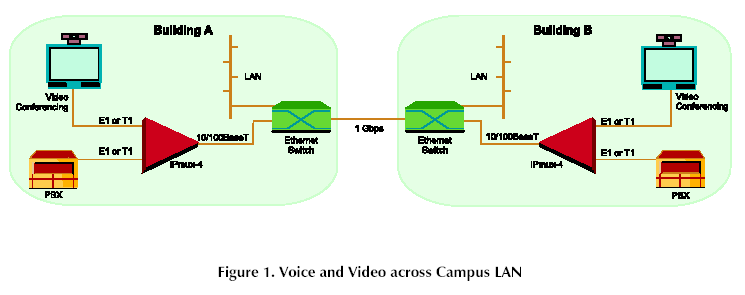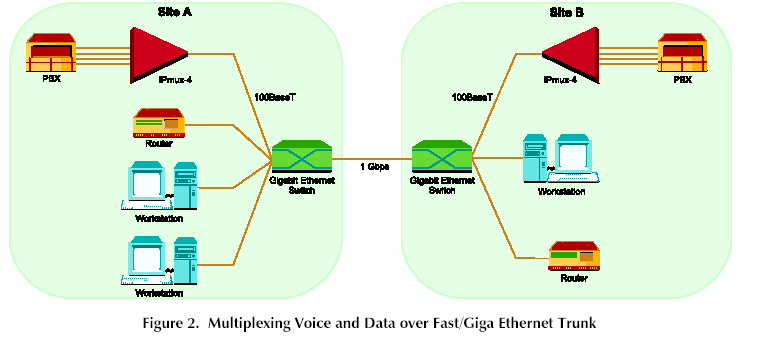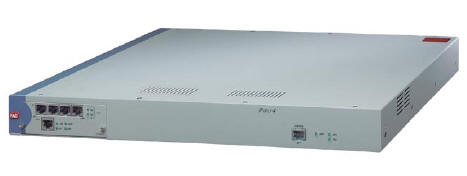|
FEATURES
-
IPmux-4 is a TDMoIP gateway
enabling E1/T1 extension over IP networks
-
Supports synchronous TDM-based
services over IP and Ethernet networks
-
Multiplexes up to 4 E1/T1
circuits
-
Supports CAS signaling and is
totally transparent to all other signaling protocols running over E1/T1
-
Extends either framed (full or
fractional) or unframed E1/T1 circuits
-
E1/T1 frames, or bundles of
timeslots, are transported over the network, based on IP addressing
-
Integrated DS0 level grooming
and cross connect between E1 or T1 ports
-
10/100BaseT uplink to the
network
-
QoS support:
-
Low processing delay (under 2
msec)
-
Enables synchronous clock
distribution across IP-based networks
-
Compensates for packet delay
variation of up to 32 msec for E1 or 24 msec for T1 circuits
-
Redundant power supplies
-
Management interfaces: SNMP,
Telnet, TFTP and XMODEM with enhanced management tools and features
-
RADview Service Center
application enables provisioning and monitoring of TDMoIP services
-
Compact platform, 1U high,
19-inch enclosure
SPECIFICATIONS
-
IPmux-4 provides a compact,
simple to configure, and easily scalable solution for transporting TDM
E1/T1 services over IP and Ethernet-based networks. IPmux-4 takes data
streams from up to 4 E1/T1 ports and converts them into packets (with an
IP addressing scheme) for transmission over the network. These packets are
transmitted via IPmux-4's 10/100BaseT port to the network. A second
IPmux-4 at the remote location converts the IP packets back into TDM
traffic.
-
IPmux-4 is a standard IP device,
supporting ICMP (ping), ARP, next hop and default gateway capabilities.
PERFORMANCE
QOS SUPPORT
-
The user can configure the ToS
(Type of Service) of the outgoing IP frames. This allows an en-route
Layer-3 router or switch, which supports ToS (or Diffserve), to give
higher priority to IPmux-4 traffic for delay-sensitive applications.
OPERATION MODES
POWER SUPPLY
TIMING
INTERFACE MODULES
E1/T1 PORT
ETHERNET PORT
-
Each E1/T1 module includes a
single, standard 10/100BaseT port with auto-negotiation support, which
provides the uplink to the network. If auto-negotiation is disabled,
IPmux-4 can be configured to any of the following:
-
100BaseT - full duplex
-
100BaseT - half duplex
-
10BaseT - full duplex
-
10BaseT - half duplex.
DIAGNOSTICS & MANAGEMENT
-
IPmux-4 supports remote and
local loop testing. End-to-end alarm generation and end-to-end AIS
indication are also provided. In the event that a local E1/T1 port
receives an AIS, it is passed to the remote port via the Ethernet/IP
network. If a local Ethernet port is not connected, an AIS indication will
be generated both in the local and the remote devices.
-
On the E1/T1 ports, SES and UAS
statistics are collected in 15-minute intervals and are stored for 24
hours (96 intervals). E1/T1 physical layer alarms (LOS, AIS, LOF, LCV) are
also supported.
-
Software download is supported
via the local terminal using XMODEM or remotely, using TFTP. After
downloading a new software version, IPmux-4 automatically saves the
previous version in non-volatile memory for backup purposes. Similarly,
copies of the configuration file may be downloaded and uploaded to a
remote workstation for backup and restore purposes.
-
RADview-HPOV, RAD's SNMP-based
network management system, provides a user-friendly graphical display that
allows monitoring and configuring of multiple IPmux-4 devices. Fault
isolation, statistics and events gathering are available. RADview-HPOV can
hold a complete predefined IPmux-4 configuration to shorten and simplify
field installation.
E1 INTERFACE
?
Ports
1 or 4 (see Ordering)
?
Standards
ITU-T Rec. G.703, G.704, G.706,
G.732, G.823
?
Framing
Unframed, CRC4 MF, CAS MF
?
Data Rate
2.048 Mbps
?
Line Code
HDB3
?
Receive Level
0 to - 27 dB with LTU
0 to - 10 dB without LTU
?
Transmit Level
Balanced: "? 3V ( 10%)
Unbalanced: ? 2.3V ( 10%)
? Line Impedance
Balanced: 120 ohm
Unbalanced: 75 ohm
? Jitter Performance
Per ITU-T G.823
? Connectors
Balanced: RJ-45, 8-pin
Unbalanced: pair of mini BNC, 75 ohm (adapter cables
from mini BNC to BNC are supplied)
T1 INTERFACE
? Ports
1 or 4 (see Ordering)
? Standards
AT&T TR-62411, ITU-T Rec. G.703, G.704, ANSI T1.403
? Data Rate
1.544 Mbps
? Line Code
AMI, B8ZS, B7ZS
? Framing
Unframed, SF, ESF
? Receive Level
0 dB to - 27 dB
? Transmit Level
? 2.75V ? 10% at 0?655 ft with DSU
0 dB, - 7.5 dB, - 15 dB, - 22.5 dB with CSU
? Line Impedance
10 0 , balanced
? Jitter Performance
Per AT&T TR-62411
? Connector
RJ-45, 8 pin
ETHERNET INTERFACE
? Ports
1
? Standards
IEEE 802.3, 802.3u
? Data Rate
10 or 100 Mbps, half duplex or full duplex
? Range
Up to 100m on UTP Cat.5
? Connector
RJ-45, 8-pin
DTE CONTROL INTERFACE
? Standards
RS-232/V.24 (DTE)
? Data Rate
9,600, 19,200, 38,400 or 57,600 bps
? Connector
DB-9
GENERAL
? Power
100 to 240 VAC, 47 to 63 Hz, 30W
- 36 to - 72 VDC
Note: Supports power supply redundancy
? Physical
Height 4.4 cm/1.7 in (1U)
Width 43.2 cm/17.0 in
Depth 35.0 cm/13.8 in
Weight 2.8 kg/6.2 lb
? Environment
Temperature:
Operating:
0 to 5 0 C/32 to 12 2 F
Storage:
- 20 to 70 C/32 to 11 0 F
Humidity: Up to 90%, non-condensing
ORDERING
IPMUX-4/48
IPMUX-4/48/R
IPMUX-4/AC
IPMUX-4/AC/R
IPMUX-4M/E1/1/ETH
IPMUX-4M/E1/4/ETH
IPMUX-4M/E1CX/1/ETH
IPMUX-4M/E1CX/4/ETH
IPMUX-4M/T1/1/ETH
IPMUX-4M/T1/4/ETH
APPLICATIONS


|

